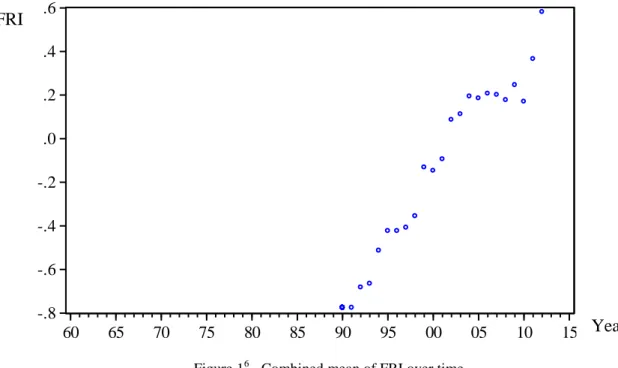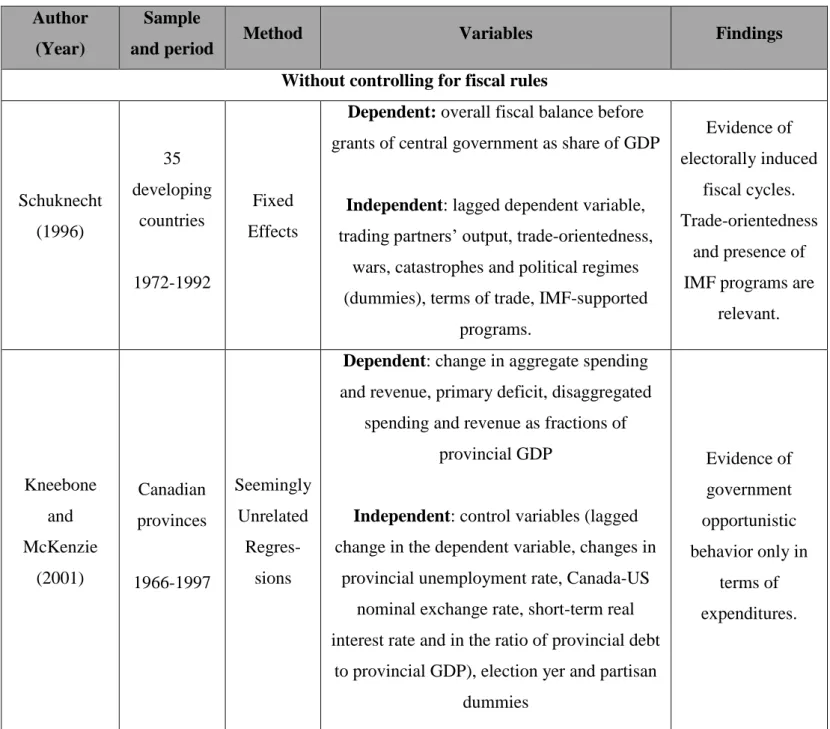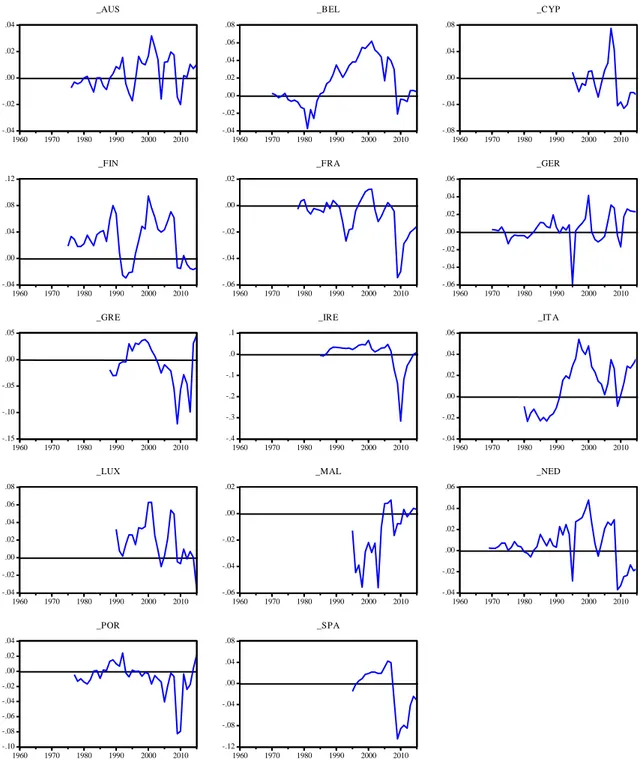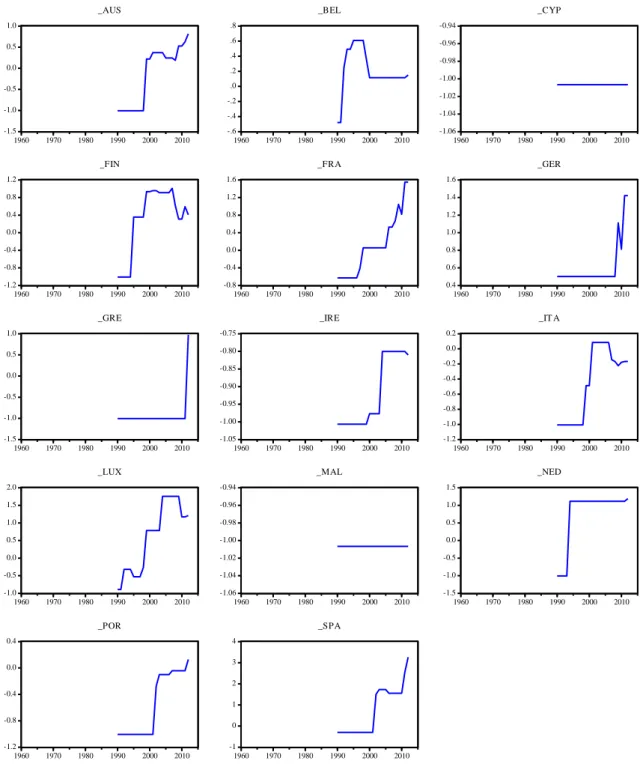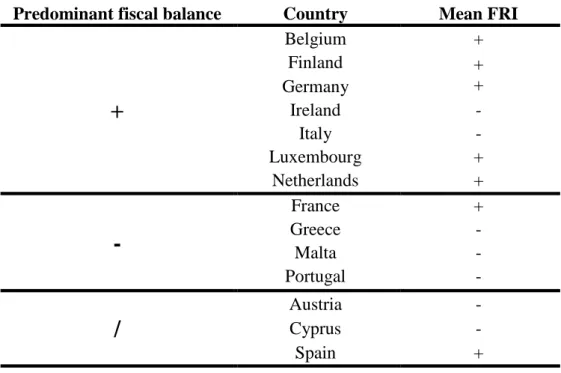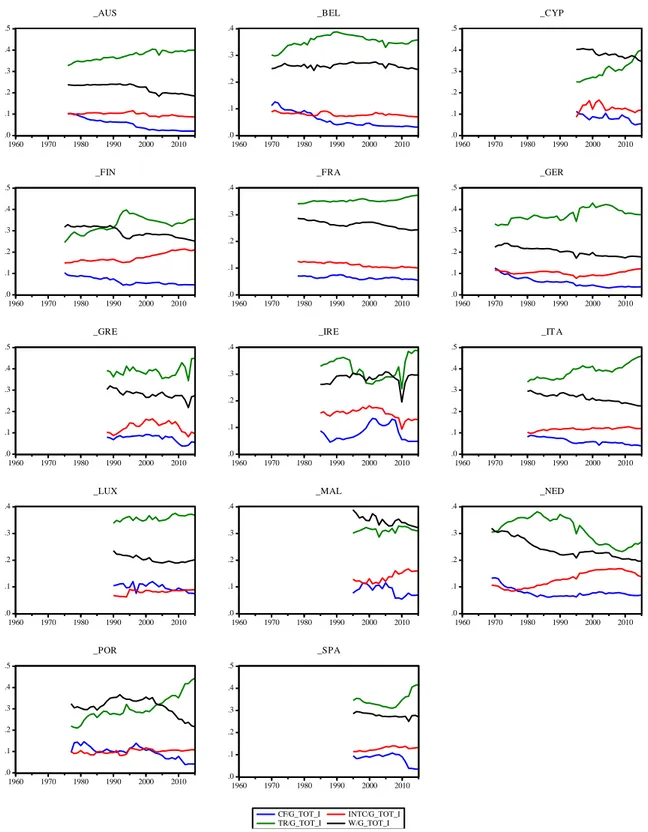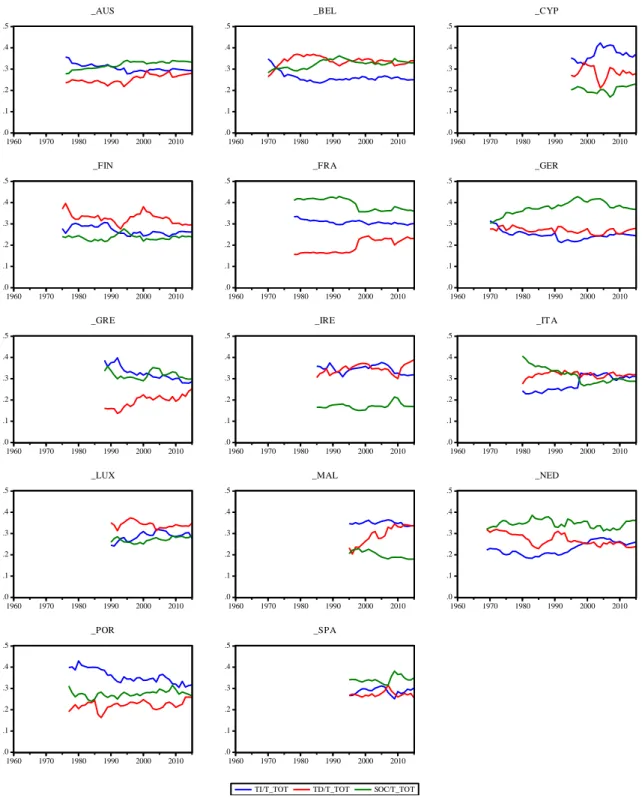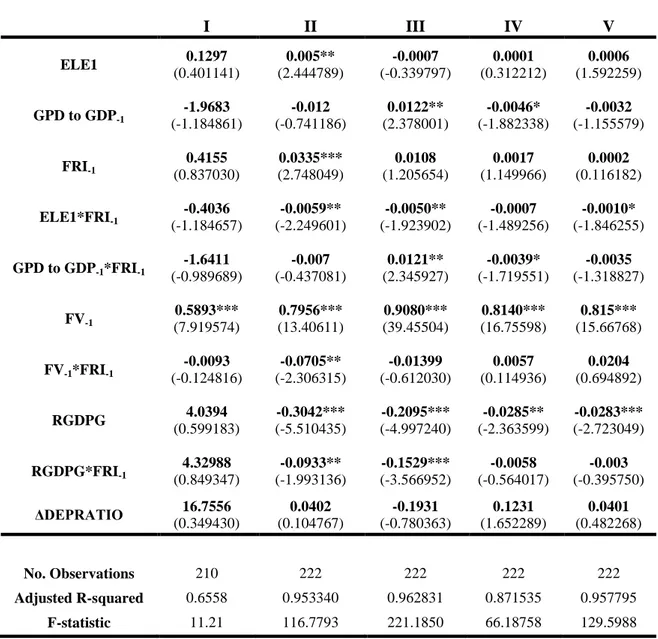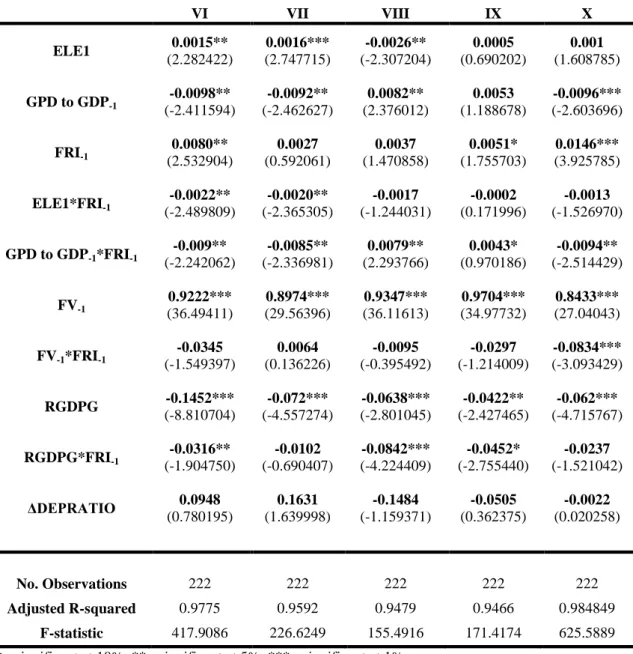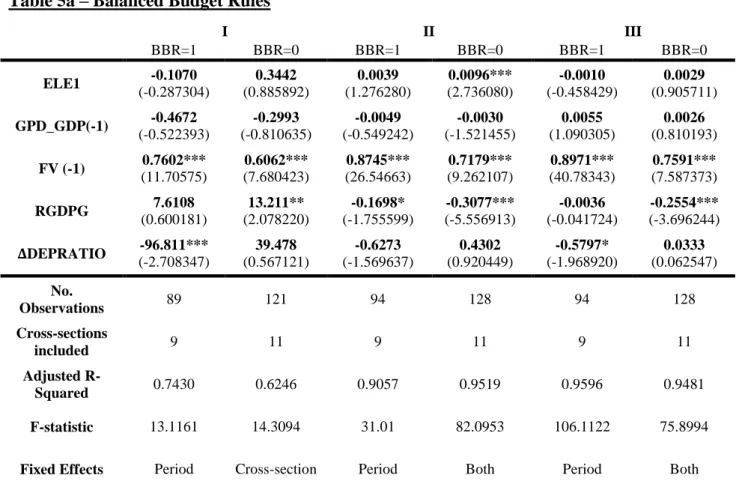Budget manipulation and fiscal rules: evidence from
the Economic and Monetary Union
Ana Filipa Santos
Master Dissertation in Economics
Supervised by
Ana Paula Ferreira Ribeiro
Vítor Manuel da Costa Carvalho
Vita
Ana Filipa Santos was born on the 18th of November, 1990 in Canada. She lived in Belgium for most of her childhood and returned to Portugal in 2004. She finished high school in Cantanhede, Portugal in the academic field of Sciences and Technologies in 2008. In February 2012, Filipa concluded her undergraduate degree in Economics at the Faculty of Economics of Coimbra University. That same year she started attending the Master in Economics at the Faculty of Economics of Porto University. She joined EY (Ernst & Young) as an Auditor in the Fraud Investigation and Dispute Services department in September 2014.
Acknowledgements
The writing of this dissertation has been one of the most significant and fulfilling experiences I have ever had, both academically and personally. There are several people who, directly or indirectly, have contributed to the successful completion of this endeavor and without whose support, patience and guidance this journey would have not been the same. To them, I owe my appreciation.
First and foremost, to my supervisors for their invaluable guidance and comments and for always asking for “that extra mile”. They were instrumental.
To my parents, for their unconditional love, support and inestimable advice. For never letting me lose sight of my objectives.
To my younger brothers, who constantly inspire me towards self-improvement and always make me feel like the best version of myself.
To my boyfriend, for believing in me more than I did myself and his unconditional support. For always being there.
To my best and most important girlfriends, the family I chose and that forces me to have fun when I forget to.
Abstract
Economic policies are almost never pursued for purely economic reasons; however politicians find justification for the majority of their actions in economics. Political intentions are thus often the cause for careless budget management and eventually lead to political budget cycles. This study aims to contribute to the literature on political budget cycles by assessing the existence of political budget cycles induced by the manipulation of budget composition. Moreover, we aim at studying the impact of fiscal rules on the occurrence of this phenomenon. In order to achieve this, our analysis was based on 14 Economic and Monetary Union Member Countries and covered the period of 1991-2007. We found no evidence of electoral cycles in budget deficits, but found instead that these cycles occur at disaggregated expenditures and revenue categories. Moreover, evidence showed that these cycles are more predominant in expenditures and in more “visible” categories, namely Social Transfers, Employee Compensation, and Direct Taxes. Even though the fiscal rules indicator does not display significant effects on its own in these categories (except in Social Transfers), it does help mitigate (accentuate) the electoral effect when its value is high (low) enough.
Keywords: political budget cycles, fiscal policy, fiscal rules, budget composition, EMU. JEL Codes: D72, E62, P16.
Resumo
Raras são as vezes em que políticas económicas são implementadas por motivos puramente económicos. No entanto, os governantes justificam as suas ações com base em princípios económicos. As intenções políticas levam assim, usualmente, a uma gestão orçamental descuidada e consequentemente ao surgimento de ciclos políticos orçamentais. Este estudo pretende contribuir para a literatura dos ciclos políticos orçamentais através da averiguação da sua existência pela manipulação da composição orçamental. Pretende-se ainda estudar o impacto que a existência de regras orçamentais apresenta para este fenómeno. Para tal, baseou-se a análise em 14 Estados-Membros da União Económica e Monetária no período de 1991 a 2007. Não foram encontradas evidências de ciclos eleitorais em termos de défices orçamentais. Contudo, verificou-se que estes ciclos ocorrem ao nível da desagregação das categorias de Receitas e Despesas. Verificou-se ainda que estes ciclos são mais predominantes em termos de Despesas e em categorias mais “visíveis” ao eleitorado, nomeadamente Transferências Sociais, Despesas com Pessoal e Impostos Diretos. Apesar de o indicador de regras orçamentais (FRI) não apresentar efeitos significativos de forma independente (exceto nas Transferências Sociais), este indicador tem um efeito mitigador (acentuador) do efeito eleitoral quando o seu valor é elevado (reduzido) o suficiente.
Palavras chave: ciclos políticas orçamentais, política orçamental, regras orçamentais, composição orçamental, EMU.
Table of Contents
Vita ... i
Acknowledgements ... ii
Abstract ... iii
Resumo ... iv
List of Tables ... viii
List of Figures ... ix
Abbreviations ... x
1. Introduction ... 1
2. From Political Business Cycles to budget composition manipulation ... 4
2.1. Political Business Cycles ... 4
2.2. Political Budget Cycles ... 6
2.3. Moral hazard model ... 8
2.4. Fiscal conservatism ... 9
2.5. A new moral hazard model and composition cycles ... 11
2.6. The conditionality of composition cycles ... 13
2.6.1. Economic development ... 14
2.6.2. Fiscal rules ... 15
2.7. EMU fiscal framework ... 19
2.7.1. Fiscal rules in the EMU throughout time ... 20
2.7.2. The Fiscal Rule Index ... 22
2.8. Empirical evidence in Political Budget Cycles ... 25
3. Rules and political budget-composition cycles: an empirical application to the EMU ... 31
3.1. A first approach ... 32
3.1.1. Fiscal deficits ... 32
Expenditure ... 35 Revenue ... 38 3.2. Econometric model ... 40 3.3. Methodology ... 41 3.4. Analysis of results ... 43 3.4.1. Net Lending ... 45
3.4.2. Aggregate Expenditure and Revenue ... 46
3.4.3. Disaggregated Expenditure ... 48
Gross Fixed Capital Formation ... 48
Intermediate Consumption ... 49 Social Transfers ... 50 Employee Compensation ... 50 3.4.4. Disaggregated Revenue ... 51 Direct Taxes ... 51 Indirect Taxes ... 52
Social Contributions Received ... 52
3.4.5. The effect of fiscal rules on the political cycle in EMU – a closer look ... 53
3.4.5.1. The role of alternative fiscal rules – a sample-split approach... 53
Balanced Budget Rules ... 54
Debt Rules ... 55
Expenditure Rules ... 56
Revenue Rules ... 58
3.4.5.2. The role of alternative fiscal rules – a dummy variable approach ... 59
4. Conclusions ... 63
References ... 66
Annexes ... 70
Annex I – Data sources and units ... 70
Annex IIa – Series statistics ... 70
Annex IIb – Series statistics (Continuation) ... 71
Annex IIc – Correlation matrix ... 71
Annex III – Hausman Tests ... 73 Annex IV – Redundant Fixed Effects Tests ... 75
List of Tables
Table 1 – Some empirical studies on political budget cycles ... 25
Table 3 – Comparison between average fiscal balance and average FRI ... 35
Table 4a – Estimation results ... 44
Table 4b – Estimation results (Continuation) ... 45
Table 5a – Balanced Budget Rules ... 55
Table 5b – Debt Rules ... 56
Table 5c – Expenditure Rules ... 57
Table 5d – Revenue Rules ... 58
Table 6a – Fiscal rule types and effectiveness ... 61
List of Figures
Figure 1 - Combined mean of FRI over time ... 24
Figure 2 - Mean of FRI by Member State ... 24
Figure 3 – Fiscal deficit-to-GDP (excluding debt service) ... 33
Figure 4 – Fiscal Rule Index ... 34
Figure 5 – Expenditure categories-to-primary expenditure ... 37
Abbreviations
AMECO – Annual Macro-Economic
ARCH – Autoregressive Conditional Heteroskedasticity ARMA – Autoregressive Moving Average
BBR – Budget Balance Rule DR – Debt Rule
EMU – Economic and Monetary Union ER – Expenditure Rule
EU – European Union FEM – Fixed Effects Model FRI – Fiscal Rule Index
FRSI – Fiscal Rule Strength Index GDP – Gross Domestic Product
GMM – Generalized Method of Moments IMF – International Monetary Fund
OECD – Organization for Economic Co-operation and Development RR – Revenue Rule
1. Introduction
Currently, the fields of Economics and Politics display a considerable level of interdependency. Economic policies are almost never pursued for purely economic reasons but, still, politicians find justification for the majority of their actions in economics. As referred by Mierau et al. (2007), the 1970s witnessed a large and unprecedented peacetime growth of several OECD countries’ public debt-to-GDP ratio, which lead these countries to adopt fiscal adjustment programs. However, this raised the question as to why this phenomenon took place. One of many possible answers put forward is the existence of political business cycles. According to this suggestion, countries displayed high levels of indebtedness due to governments’ political preferences and need for reelection.
Since Nordhaus’ (1975) approach to the concept of political cycles, literature has evolved considerably and has, since then, become more disperse and covers now a wide range of different topics. This study aims to contribute to one of the more recent strands in Political Economy literature – that of arguing the existence of political budget cycles induced by the manipulation of budget composition rather than through the management of revenues or expenditures as a whole. In other words, this study intends to verify the occurrence of political budget cycles that do not result in the deterioration of government deficit, but that are, instead, a result from governments’ choice to shift towards some categories of expenditure and/or revenue.
This study also intends to evaluate the impact of fiscal rules on the occurrence of this type of political budget cycles. According to the European Commission1,
“fiscal rules set numerical targets for budgetary aggregates” and “pose a
permanent constraint on fiscal policy, expressed in terms of a summary indicator of fiscal outcomes, such as the government budget balance, debt, expenditure, or revenue developments”.
Hence, fiscal constraints should be sufficient to deter aggregate manipulations of government expenditures and revenues and should therefore reduce political budget
1 Information obtained at:
http://ec.europa.eu/economy_finance/db_indicators/fiscal_governance/fiscal_rules/index_en.htm (accessed on December 15, 2013).
cycles (or at least, their magnitude). The question is: if given these restraints and the incentives of governments to secure their reelection, will governments manipulate budget composition at a more disaggregate level? And if so, which target budget categories will be manipulated to alter the composition of the budget without violating fiscal rules? Are there certain types of fiscal rules more efficient than others in deterring governments from incurring in fiscal cycles?
The Economic and Monetary Union (EMU) is an example of a group of countries voluntarily bounded by common, as well as country-specific, fiscal rules and is therefore an interesting case to study. Countries of the EMU are subject to rules established in the Stability and Growth Pact (SGP); even though this pact is applicable to all European Union Member States, it has stricter enforcement mechanisms for members of the Eurozone. Among other rules, the SGP imposes reference values for national budget deficits (at 3% of GDP) and public debt (at 60% of GDP). If EMU Member States violate these rules, sanctions are imposed. These sanctions are only applicable to Eurozone countries and are, thus, an example of enforcement mechanisms. This dissertation aims to be a valuable contribution to the existing literature by not only reviewing the literature on budget composition political budget cycles and its empirical results, but also by analyzing if the EMU Member Countries’ experience in terms of occurrence, magnitude and budget composition of political budget cycles was altered after joining the EMU, due to more stringent fiscal rules. Another interesting aspect would be to understand if there are specific types of fiscal rules that are more efficient in managing electoral cycles.
The empirical approach is inspired by the standard literature and employs the Fixed Effects Method to estimate the effect of electoral, political, demographic and fiscal variables on fiscal categories. The panel comprises data on the “nuclear” Economic and Monetary Union Member States between 1991 and 2007, in order to exclude observations during the most recent financial crises. The analysis is then extended by firstly including a simple coefficient comparison between regressions for each fiscal variable with and without the consideration of each type of fiscal rule, and then introducing fiscal rule and election dummy interaction terms.
This thesis is organized as follows. Section 2 briefly presents the historical context of political business cycles literature and its evolution towards fiscal cycles and
political cycles in budget composition. This section also provides an overview of numerical fiscal rules in the Economic and Monetary Union and surveys empirical literature and its main results. Section 3 describes the methodology, the data and the obtained empirical results from our empirical application to the EMU countries. Section 4 concludes.
2. From Political Business Cycles to budget composition
manipulation
2.1. Political Business Cycles
As Tufte (1978) states (cfr. Chang, 2008, p. xi):
“The single most important fact about politicians is that they are elected. The second is that they usually seek reelection.”
In order to be reelected, governments are tempted to pursue public policies that are perceived to generate higher levels of public well-being. Governments would therefore stimulate the economy and attempt to maximize votes by improving/influencing economic outcomes. This phenomenon has come to be known as political business cycles. According to Shi and Svensson (2003), political business cycles are a result from the interaction between elections and real economy outcomes, particularly inflation and unemployment rates.
Nordhaus (1975) was the first author to formalize a model describing a political business cycle. His pioneer study considered a setting in which the economy can be described by an exploitable Phillips curve where voters form backward-looking expectations; hence, the number of votes depends on recent economic outcomes, such as inflation and unemployment rates. In this model it was also assumed that governments did not display partisan differences, their sole objective being to secure reelection, and that governments could manipulate (monetary) policy instruments in order to stimulate aggregate demand and influence the inflation rate. The author thus postulated that governments would exploit the Phillips curve by conducting expansionary monetary policies which would diminish the economy’s unemployment rate and improve voters’ (perceived) well-being.
Relying on both theoretical and empirical grounds, Nordhaus’ model was highly criticized. For instance, the fundamental assumption that the governments are able to exert control over monetary policy is not consistent with the central bank independence hypothesis. The rational expectations revolution showed that there were other flaws in
Nordhaus’ (1975) formulation, such as the fact that the author assumed voters behaving backward-looking matter when forming expectations and assessing the governments’ competence. Moreover, the fact that fiscal policy was not taken into consideration was also criticized.
In 1977, Hibbs presented his view on the political business cycle and developed the partisan model, also based on an exploitable Phillips curve in which, unlike in Nordhaus’ (1975) model, different parties display different macroeconomic goals and preferences. In this case, a government’s objective is not only to be reelected, but also to maximize its party’s economic preferences. Following empirics, the model assumes that parties on the left wing tend to penalize higher levels of unemployment and thus prefer to bear the cost of high inflation rates. On the other hand, parties on the right wing tend to be more conservative and prefer lower inflation rates. Consequently, left-wing governments will pursue more expansionist monetary policies. According to the author, the macroeconomic fluctuations one observes in the economy are mainly driven by government partisan preferences in terms of inflation and unemployment rates. During elections, voters intend to elect governments closer to their personal economic preferences. However, Hibbs’ (1977) model was subject to the same line of criticisms as Nordhaus’ (1975).
Given the problems identified in both aforementioned models, these were revisited and reformulated after the rational expectations revolution. These new models incorporated voter rationality by taking into account how voters formed expectations about future policy and how they would act upon those expectations through elections. The existence of opportunistic electoral manipulation despite voter rationality is justified through the concepts of “imperfect information” regarding the competence of governments and “uncertainty” (Drazen, 2001).
The partisan perspective was reformulated by Alesina (1987) and the rational partisan model was developed. The author argued that political business cycles arise only when the electoral outcome and the inflation rate are uncertain. The expected inflation rates are directly determined by the winning party; if there is certainty regarding the winning party, there is no cycle. Under uncertainty, if the elections are won by a left-wing party, there is a positive surprise regarding inflation and there is a decrease in the unemployment rate. Then again, if a right-wing party is elected, there is
a negative surprise concerning the inflation rate and there is a rise in the unemployment rate. Consequently, the magnitude of the cycle is determined by the level of electoral uncertainty and the differences between the targets for the inflation rate of each party.
Rogoff’s (1990) rational opportunistic model assumed that voters form rational expectations regarding the inflation rate but that, at the time they form these expectations, available information is rather incomplete. In particular, voters have no information regarding the government’s competence (their ability to combine low rates of both unemployment and inflation). The author suggests that governments in function have an incentive to explore the information asymmetry regarding their competence. Thus, political business cycles would therefore result from government’s attempts to signal their competence to the voters.
A lack of empirical evidence regarding real effects in the economy combined with an
“implausibility of key assumptions” (Drazen, 2001, p. 76)
and the inability on behalf of the policymakers to directly affect these outcomes rendered the concept of political business cycles purely theoretical, as put by Drazen (2001, p. 77):
“… models based on manipulating the economy via monetary policy are unconvincing both theoretically and empirically, while explanations based on fiscal policy conform much better to the data and form a stronger basis for a convincing theoretical model of electoral effects on economic outcomes.”
2.2. Political Budget Cycles
More recent strands of literature evolved towards the concept of political budget cycles. The inability to control economic outcomes, partly due to the adoption of independent central banks, forces governments to adopt expansionary fiscal policies (either increasing public spending or cutting taxes) in order to achieve their ultimate goal of reelection, thus creating political budget cycles (Schneider, 2010). These differ
from political business cycles in the sense that governments do not try to manipulate economic outcomes but rather induce cycles by influencing fiscal variables such as public spending, taxes and budget deficits (de Haan and Klomp, 2013). Further, according to Efthyvoulou (2012), political budget cycles describe a phenomenon in which fiscal policies differ pre- and post-electorally due to governments’ opportunistic behavior. Contrary to the seminal contributions, this next generation of models accounted for the fact that fiscal policy could also be used to enhance governments’ advantage and highlighted the role of information asymmetries.
Several authors tried to ascertain the existence of political budget cycles and the general empirical conclusion is that these phenomena are not unconditional, meaning that they occur in specific samples of countries.
Schuknecht (1996) was among the first authors to examine the existence of electorally induced fiscal policies in developing countries. Employing an annual panel of data regarding 35 developing countries in the period between 1972 and 1992 the author tests several hypotheses. Firstly, the author tests for overall fiscal deficit increases in electoral years and predicts that in developing countries it should be easier (and more easily observable) for governments to increase expenditures rather than to decrease taxes, as in these countries the tax base is rather small. This hypothesis is confirmed by the empirical results, which suggest that the electoral effect is considerable (almost 0.7 percent of GDP). Results further indicate that this effect is much larger in less trade-oriented countries (almost 1% of GDP), as predicted by the author. Finally, the author considers the effect of IMF-supported programs on fiscal deficits. These programs promote economic stabilization and fiscal consolidation and encompass greater budget constraints in countries, which would ultimately lead to smaller fiscal deficits, even in the short-term. Due to these countries’ small public sector and rather large informal sector, the recessionary effect of fiscal consolidation should be mitigated. Again, the results confirm the author’s hypothesis and show that these programs improve the fiscal balance.
For example, Shi and Svensson 2006) tried to determine whether there were differences in terms of magnitude and occurrence of political cycles between industrialized and developing countries. Their study included data from 85 countries (both developed and developing) during the period of 1975-1995. Results indicated that
political budget cycles do occur and that, on average, government deficit (as a share of GDP) increased by almost 1 percentage point in election years; this means that, on average, fiscal deficit increased by 22% in election years. However, by dividing the sample, a second regression indicated that political budget cycles in developing countries were much larger. The study showed that the average developing country experienced a 1.3 percentage points worsening of its fiscal balance in election years, whereas this decrease in the average developed country was only by 0.1 percentage points. The authors suggested that such diverging results were due to institutional features as those, for instance, that imposed constraints on politicians (in developed countries), barely leaving room for government fiscal manipulation.
Following these results, Brender and Drazen (2005) tried to understand whether the political budget cycles found in these large cross-sections of countries were due to the presence of “new democracies” in the sample. The authors believed that contrary to established democracies, new democracies may experience political budget cycles as the voters are not accustomed to electoral politics or possibly lack the ability to correctly distinguish fiscal manipulation. In their study, the authors used data from a 68-country sample covering the period 1960-2001 and ran several regressions. First, they tested a sample with several developed countries and then proceeded to remove four new democracies (Portugal, Spain, Greece and Turkey) to find that, in the second regression, the fiscal budget cycle disappeared. They then proceeded to do the same with less-developed countries and again concluded that the significant deficit cycle in the complete sample was due to the presence of new democracies.
2.3. Moral hazard model
More recently, the literature evolved and started to consider the importance of (temporary) information asymmetries between voters and politicians regarding the competence of the latter in explaining political budget cycles. These models were inspired by Rogoff’s (1990), which suggested that competence signaling could be obtained by turning to easily observed spending categories while cutting back on other expenses, and lead to the development of moral hazard models (instead of adverse selection). As argued by Shi and Svensson (2003), in moral hazard models perceived competence is proxied by the government’s productivity (the ability to produce more
public goods with the same revenue), while in adverse selection models the competence level is unknown both to politicians and voters.
Shi and Svensson (2006), building on the work of Persson and Tabellini (2000), developed a moral hazard model to explain differences in political budget cycles between developed and developing countries which highlighted the incumbent government’s ability to manipulate policy instruments in order to bias voters’ preferences. To increase his chances of reelection he attempts to signal his competence to the voters (through the supply of public goods). All politicians share the same incentive, which depends on the politico-institutional environment. The more private gains politicians earn when in power and/or the greater the share of voters unable to detect pre-electoral manipulations, the stronger their incentives to signal their competence. The authors’ empirical study showed that, on average, countries with more rent-seeking activities (higher levels of fiscal manipulation) had larger electoral budget cycles. Results also showed that a greater share of informed voters lead to smaller political budget cycles. Constraints imposed on developed countries’ politicians and the higher level of informed voters in these countries lead to smaller political budget cycles, when compared with developing countries.
2.4. Fiscal conservatism
Increasing government expenses or reducing revenues and therefore creating a deficit in election years may not always lead to the expected increase in votes. Peltzman (1992) was among the first to argue that voters punish increases in government spending and that
“Basically, every extra dollar is equally bad.” (Peltzman, 1992, p. 329).
More recently, authors such as Drazen and Eslava (2010) showed that voters are “fiscal conservatives” and that, as suggested by Peltzman (1992), an increase in government deficit may in fact harm the incumbent’s chance of being reelected. According to this, one might then argue that political budget cycles couldn’t exist since governments would lose their incentive for electoral manipulation.
Brender and Drazen (2005) found evidence of larger budget cycles in new democracies. Naturally, the authors tried to understand why these differences existed. They believed that these might be due to factors such as the availability of political and economic information to the voters and their ability to interpret it, access to media (which would give access to this information) and experience (or lack thereof) with elections. In new democracies there is generally less information available to the electorate. These factors, combined with the lack of experience with elections, render most voters unable to correctly identify fiscal manipulation, which are thus more likely to “reward” election-year deficits. Brender (2003), cfr. Brender and Drazen (2005), illustrated this explanation. The author found evidence of a shift in electoral response to election-year deficits in local Israeli elections. When the elections were first introduced, voters were unconcerned with deficits. By the time reporting standards were introduced and media grew, local voters began punishing deficits. The aforementioned authors argued that their results combined two opposing ideas regarding pre-electoral manipulation: on the one hand they confirm that politicians will engage in fiscal manipulation, but on the other they also support the fact that fiscal budget cycles occur regardless of the existence of fiscal conservatives, since their findings indicated that in new democracies voters may reward election-year deficits and punish them in established economies.
The premise by which voters respond directly to electoral policy and thus penalize government incurring in deficits was empirically explored by Drazen and Eslava (2010) who looked at data from Colombian mayoral elections in the period between 1992 and 2000. The authors defined the share of votes obtained by either party (Liberal and Conservative) as a function of preelection fiscal policy choices by the incumbent party. The empirical results corroborated the initial premise: voters penalize incumbents that run high deficits
However, recent studies (e.g., Kneebone and McKenzie, 2001 and Drazen and Eslava, 2010) take the existence of fiscal rules into consideration and argue that these might influence governments to manipulate the budget at a more disaggregate level instead of the overall budget for political gains. Tsai (2014) poses the question as such:
“… could speculative politicians manipulate spending within disaggregated
public expenditure categories for electoral gains? Or do binding balanced budget requirements limit such manipulation?” (Tsai, 2014, p. 59).
The same author considers that the incentive to influence voters by manipulating government budget at a disaggregated level allows for government opportunistic behavior without disregarding the assumption of voter rationality (Tsai, 2014). The literature proceeded to analyze the topic of political budget cycles induced by the manipulation of the disaggregated budget.
2.5. A new moral hazard model and composition cycles
Keeping in mind that voters are “fiscal conservatives”, another moral hazard model was developed by Drazen and Eslava (2010) as to model situations in which governments attempt to signal their competence by changing government spending composition instead of global revenues or spending. In this model, the authors consider a two-period framework and an election between the incumbent and a challenger at the end of the first period. According to the model, the incumbents can only alter the composition of the budget and not its overall level. Therefore, incumbents may use the composition of the budget (and particularly expenditures) to attract votes. It is assumed that all voters share the same budget composition preference, so there is only heterogeneity between voters and politicians. In the decision of which candidate to support, voters face a trade-off between ideology over non-fiscal policy and utility from targeted expenditures. Moreover, politicians are bound by a budget constraint since there are goods that are valued by politicians but not by voters.
According to the authors, voters value some types of spending more than others. An incumbent can try to signal his competence by shifting the composition of government spending towards voters’ preferences. This opportunistic shift in government expenditures towards more “visible” categories is referred to as: “pork
barrel spending”. Political manipulation therefore takes the form of changing the
composition of government spending and voters can (rationally) respond to these spending shifts. Thus, political budget cycles may occur even if voters are fiscal conservatives.
The authors applied this model to Colombian municipalities and found that this shift in government spending usually means that there is a decrease in current expenditure before the elections (particularly through cuts in transfers to pensioners and payments to temporary workers) and an increase in spending related to development projects (such as health, water and energy infrastructures, and housing). Specifically, the authors discovered that spending grows by 2% and that current transfers suffer a decrease of about 10%, in election years. The results confirmed what the authors knew
a priori: Colombian voters highly value infrastructure development projects as these
investments are largely visible and beneficial to large groups of the population. Furthermore, the authors' results indicated that voters punish incumbents for incurring in high deficits.
Kneebone and McKenzie (2001) studied Canadian provinces during the period of 1966-1997 in order to verify if, as predicted by Rogoff’s (1990) model, governments will increase spending in areas that are most visible to voters. Contrary to Rogoff (1990), the authors believed that the distinction should not be made in terms of current versus capital expenses but rather in terms of “visible” and “less visible” expenses. In the Canadian context, the fact that most expenditures are of shared responsibility between local and federal government makes it difficult for voters to attribute responsibility for certain expenditures and thus limits the local governments in signaling their competence to voters. The authors called this dimension the “identifiability” of an expenditure category with local government. Somewhat subjectively, the authors considered that
“the four expenditure categories of Education, Transportation and
Communication, Recreation and Culture, and Protection” (Kneebone and McKenzie,
2001, p. 767)
are both visible and identifiable as local government responsibilities. Evidence confirmed Rogoff’s model and showed opportunistic effects during election years across the expenditure categories, driven by a decrease in spending in less “identifiable” categories (such as health and industrial development) and an increase in more “visible”
categories such as education, transportation and communication, and recreation and culture.
Another interesting contribution to this line of investigation is that of Chang (2008), who combines the composition aspect of political budget cycles with differences in electoral systems and veto players structures. The author used cross-country data on 21 OECD countries between 1973 and 2000 and focused particularly on district-specific spending and social welfare spending and analyzed their connection with single-member district and proportional representation electoral systems. Following Alt and Lassen (2006), Chang (2008) theorized that political budget cycles in advanced economies only occur if the regression controls for a certain institutional feature. The empirical results support this premise as the author does not find significant election year effects in the regression without electoral system and veto player structure conditioning. The author further concludes that there is a difference in targeted spending in different electoral systems: under proportional representation incumbents target social welfare, whereas in single-member district systems the preference goes to localized district-specific spending.
More recently, Efthyvoulou (2011) focused his research on Cyprus (1978-2006) and tried to examine the existence of political cycles in this small, open economy. The author’s findings, on one hand, showed that partisan effects regarding budget deficits had been becoming less pronounced over the years due to an increase in the level of globalization, even disappearing in later years of the sample as Cyprus prepared to join the EMU. On the other hand, as partisan effects seem to have practically disappeared, the increasing globalization lead to a prevalence of opportunistic effects and to stronger electoral cycles in more visible categories of the fiscal budget.
2.6. The conditionality of composition cycles
Empirical studies also explored why these cycles were so “conditional” and literature started to evolve towards the notion that the magnitude of political budget cycles might depend on countries’ institutional features. These features include factors such as the level of economic development, the endogeneity of election dates, age and level of democracy (Brender and Drazen, 2005; Shi and Svensson (2006); Klomp and de Haan, 2013), political rent-seeking and media access (as suggested by Shi and Svensson, 2006) or political factors such as fiscal transparency and political polarization
(Alt and Lassen, 2006; Klomp and de Haan, 2013). However, all these factors considered lean towards the idea that the main differentiating aspect is the level of development.
2.6.1. Economic development
Shi and Svensson (2006) considered that there was a gap in the literature regarding the universality of the political budget cycle phenomenon and particularly concerning possible differences between developed and developing countries. As previously mentioned, the authors concluded that there were indeed significant differences between the two sets of countries; developing countries tend to have larger budget cycles. They attributed these differences to the existence of different politico-institutional features, such as the politicians’ rent of being in power and the share of informed voters, i.e., voters with the ability to distinguish political manipulation from governments’ competence. They constructed a moral hazard model in which the size of political budget cycles depends on political rent-seeking, i.e., the more the government benefits of remaining in power, the more prominent the electoral cycles. They analyze this fact by using two proxies for rents: the first one is based on a country’s corruption index and the other proxy is constructed with help of the International Country Risk Guide. Their empirical evidence supports their initial hypothesis; the electoral effect is much higher in countries with higher corruption levels2 and more rent-seeking activities. Further, the authors argue that the share of informed voters makes a tremendous difference in electoral cycles between these two groups of countries and assume that there are two types of voters: “informed” and “uninformed” voters. The “informed” voters have access to various kinds of information and can observe virtually every aspect of government policy. “Uninformed” voters do not have access to much information, nor can they observe every policy instrument. In order to proxy for this feature, the authors use data on access to media as well as media freedom. As expected, the empirical analysis concludes that the share of informed voters is indeed an important differentiating factor between electoral cycles in developed and developing countries; higher shares of informed voters conducts to smaller budget cycles. In their review of
2 The electoral effect in countries with an average corruption level of developed countries is 0.1% of
GDP. Countries with higher average corruption levels (developing countries) have an electoral effect of 1.9% of GDP (Shi and Svensson, 2006).
recent literature, de Haan and Klomp (2013) refer to a finding of Alt and Rose (2009) which suggests that there are stronger election cycles in US states where newspaper access is lowest.
Another important factor is put forward by Brender and Drazen’s (2005) analysis. Their data panel supports the existence of political budget cycles in a large sample of countries. However, the authors argue that this evidence is due to the presence of non-democratic countries in the sample. Their reasoning behind this argument is that “old” and experienced democracies are less prone to fiscal cycles because their voters are not only better informed regarding governments’ fiscal policies, but are also more capable to process that information as they have far more experience as far as elections go and are thus less likely to reward fiscal deficits. This theory was later tested by Klomp and de Haan (2013) which concluded that the election effect is significantly higher in young democracies (countries who have been democratic for less than 20 years).
A last factor considers that the voters’ decision making process is a crucial part of what determines fiscal cycles. According to Alt and Lassen (2006), fiscal transparency is central to this concept since it allows voters to identify fiscal manipulation. Using data on 19 OECD countries in the 1990s, the authors were able to find evidence of persistent cycles in low transparency countries, as opposed to none in high transparency countries.
2.6.2. Fiscal rules
The existence of firm fiscal frameworks and particularly fiscal rules constitutes another important institutional feature that greatly affects the magnitude of political budget cycles. Literature addressing the role of fiscal rules in the occurrence of political budget cycles has become increasingly relevant due to growing evidence supporting superior budgetary results as fiscal rules are introduced (for instance, Casals et al., 2007). De Haan and Klomp (2013) surveyed studies that analyzed the influence of different factors conditioning the occurrence of political budget cycles and electoral budget manipulation. Their main conclusion regarding studies on the effect of fiscal rules is that, while there is a consensus that
“…fiscal rules may reduce the electoral distortion of fiscal policy” (de Haan and Klomp, 2013, p. 402),
it is not yet clear what type of fiscal rules are most effective in terms of preventing political budget cycles. However, the effect of higher levels of budgetary transparency on the effectiveness of fiscal rules is largely agreed upon.
Rose (2006) studied American states in 1974-1999 in order to assess if fiscal rules that limit or prohibit deficits, should they be thoroughly enforced, could have an impact on the politicians’ ability to manipulate fiscal policy for political gains. In this study, the fiscal rules considered were the so-called “no-carry” rules which determine which states are not allowed to “carry over” deficits into the next fiscal year. The author also took into account the fact that in states with “no-carry” rules, these are easier to circumvent (by borrowing) in some states than in others. First of all, results indicated that states with “no-carry” rules experienced weaker political business cycles than the others. Secondly, evidence also showed that when controlling for weak and strict “no-carry” rules, states with strict rules had almost no change in budget balances during election years, whereas in states with weak “no-carry” rules the variation in budget balance was about half of that of states without rules. The author also concluded that in this sample political budget cycles were mostly driven by expenditure-side cycles.
Ebeke and Ölçer (2013) studied another subsample of countries in order to investigate the existence of political budget cycles. These authors opted to study Low-Income countries as these have weak institutions and almost non-existing transparency when it comes to the fiscal budget, which makes this subsample highly vulnerable to the manifestation of electorally-induced cycles. They considered Low-Income countries to be the ones that benefited from
“the International Monetary Fund Poverty Reduction and Growth Trust as of
2010” (Ebeke and Ölçer, 2013, p. 5).
Their sample was composed of 68 countries, 51 of which had had at least one election during the period between 1990 and 2010. The authors’ main conclusions were that there is a decline in the overall deficit during election years (a worsening by about 1 percentage point of GDP) but that cycles are also evident in both expenditures and tax revenues. Results indicated a slight decrease in government investment as a share of GDP in post-election years while consumption as a share of GDP showed a slight
increase during election years. The authors also found some evidence of increased trade tax collection during the election year and in the two following years. The empirical study also showed that the prevalence of political budget cycles was much lower not only in countries which have defined national fiscal rules, but also in countries which are subject to IMF programs. On a related note, Ebeke and Ölçer (2013) also believed that the manner in which governments opt to manipulate fiscal policy and consequently eliminate the resulting budget deficit has an important role in the potential economic growth of these countries due to the painful fiscal adjustment in need after the elections.
Tsai (2014) used data from 46 American states between 1977 and 2008 in order to ascertain whether the existence of fiscal rules would lead to governments manipulating public expenditures in a disaggregated manner, shifting expenditures from less visible categories towards more visible ones for electoral purposes. The author’s empirical findings show that fiscal rules alone do not deter disaggregated budget manipulation, in the sense that there is some shifting from and to several categories prior to election. However, the empirical conclusions also show that these manipulations decrease as “carry over” rules become more stringent, which indicates that balanced budget rules are effective both at aggregate and disaggregate levels.
Buti and van den Noord (2004) found that the “disappointing” experience of the EMU in terms of compliance with the Stability and Growth Pact (high deficits in countries like Germany, France, Italy and Portugal) was mainly due to governments’ incentives to run political (expansionist) fiscal policies during elections.
Andrikopoulos et al. (2004) tried to understand if European Union Member States used fiscal policy for macroeconomic stabilization or for political purposes and, if the latter being the case, if this behavior was influenced by the Maastricht Treaty. They analyzed data from EU-15 (excluding Luxembourg due to data limitations) for the 1970-1998 period. Overall, results suggested that these Member States had not been using fiscal policy as to create cycles during elections. The authors considered these results to be quite encouraging and believed these were an indication of converging economic policies in the Member States with the ultimate goal of forming an EMU.
Mink and de Haan (2006) focused on Euro Area-12 countries (since these have more stringent fiscal rules than other EU member countries) and tried to determine whether, despite the existence of the Stability and Growth Pact (SGP), there were
political budget cycles in these countries, using data from 1999-2004. Their main conclusion was that the SGP was not sufficiently stringent to dissuade politicians from incurring in expansionary policies right before the elections.
Using data on West German states from 1970 to 2003, Schneider (2010) sets out to understand if cycles in fiscal policies exist despite institutional constrictions such as numerical fiscal rules concerning deficits and the fact that voters tend to punish high deficits. The author’s theory suggests that while there would not exist budget or overall expenditures cycles, these would be apparent in visible budget items such as social security expenditures. Indeed, the author finds that in preelection years there is a clear incentive on the incumbent’s part to reduce the deficits, which clearly demonstrates an attempt to signal competence towards fiscally conservative voters. Further, the model clearly indicates a growth in social security spending in preelection year (almost 2%). More importantly, when controlling for the structural break in 1993 (when the Maastricht treaty limited the Bundesbank’s monetary policy autonomy), the model shows that social security expenditures grew by 4% after 1993. The empirical analysis lends clear support to the hypothesis that constrained incumbent policymakers will resource to specific expenditure policies to gain voter support.
Efthyvoulou (2012) investigated the presence of political budget cycles in fiscal policy variables in the European Union-27, studied their variation over time and evaluated if there are cross-country differences due to institutional differences. Overall, results indicated that there were indeed political budget cycles present in the European Union. In order to assess cross-country variation the authors ran a series of tests controlling for several conditions, one of which was performed by dividing the sample into Eurozone and non-Eurozone countries. Results were interesting and indicated that the evidence for political budget cycles in the EU-27 was determined by the Eurozone countries. The authors attributed this result to the fact that countries that are not part of the Euro prefer a combination of fiscal and monetary measures to induce political business cycles. The author’s main conclusion was (as in Mink and de Haan, 2006) that the Stability and Growth Pact was not sufficiently strict and thus unsuccessful in preventing political business cycles within the European Union.
Nerlich and Reuter (2013) surveyed literature on fiscal rules and used data on national fiscal frameworks for countries in the EU27 for the period 1990-2012 in order
to analyze the impact of different fiscal rules on fiscal discipline on a disaggregated level and also concluded that primary balance is significantly improved when fiscal rules are in place. They found that numerical fiscal rules have a stronger impact on budget categories of great interest from a political budget cycle perspective such as social benefits, employee compensation, and general public services.
Eslava (2011) reviewed the literature concerning political explanations for the existence of fiscal deficits and highlighted the important role of budgetary institutions on fiscal outcomes. The author believes that fiscal rules should definitely lead to more fiscal discipline. However, the author also points out the fact that governments tend to circumvent the majority of these rules, engaging in “creative accounting”. Hence, rules that are too restraining can themselves be an incentive to circumvent the rules (Milesi-Ferretti, 2003, cfr. Eslava, 2011).
Even though there is no generalized consensus regarding the effect of fiscal rules on the occurrence of political budget cycles, the European Commission is resolute in consolidating the fiscal framework in EU Member States as they regard it as an important factor in mitigating the deficit bias.3
2.7. EMU fiscal framework
According to the European Commission (2010, p. 73), domestic fiscal frameworks are
“the set of elements of the institutional policy setting that shape fiscal policy making at the national level. They comprise the arrangements, procedures and institutions governing the planning and implementation of budgetary policies.”
These frameworks are composed of: numerical fiscal rules, independent fiscal institutions, medium-term budgetary frameworks and budgetary procedures governing the preparation, approval, and implementation of budget plans. Fiscal institutions, enforcement mechanisms and an appropriate overall institutional framework are key to guarantee the implementation of fiscal rules and their effectiveness.
3Source:
http://ec.europa.eu/economy_finance/db_indicators/fiscal_governance/index_en.htm. Accessed on July, 5th 2014.
Among others, one of the main objectives of fiscal governance is to reduce short-term approaches to fiscal policy making. This aspect is particularly relevant for the purpose of this study as it would decrease the possibility of governments incurring in political cycles. Specifically, this study focusses on the impact of numerical fiscal rules on the occurrence of political cycles given evidence in the literature of their impact on deficit bias.
According to Kopits and Symansky’s (1998) definition (cfr. Debrun et al., 2008, p. 301) fiscal rules are
“a permanent constraint on fiscal policy, expressed in terms of a summary
indicator of fiscal performance”
with the main goal of promoting budgetary discipline and macroeconomic stabilization. Casals (2012) considers that numerical fiscal rules have been instrumental in solving two problems concerning fiscal policy: the “deficit bias”, i.e., increasing deficits and public debt ratios in most advanced economies attributed to governments’ shortsightedness and the “common-pool problem”, and pro-cyclicality in fiscal policy with governments overspending during economic upturns.
The Economic and Monetary Union is an exceptional public finance arrangement between Member States with the Stability and Growth Pact (SGP) as fiscal pillar. Broadly put, the SGP sets numerical constraints for countries’ deficit-to-GDP and public debt-to-GDP in order to enforce balanced budgets but also to allow automatic stabilizers to play a role in economic upswings and downswings (Buti and van den Noord, 2004). Furthermore, the preventive arm of the SGP requires countries to achieve country-specific objectives on a medium-term (MTO’s) (European Commission, 2013).
2.7.1. Fiscal rules in the EMU throughout time
Fiscal rules in the European Union have experienced a positive evolution since 1990. Since then, the number of numerical fiscal rules increased almost sixfold until 2011, going from 13 to 77 numerical fiscal rules (Mierau and Andreu, 2014). This increase was mainly due to increases in the number of balance budget, debt and expenditure rules, as revenue rules were only introduced in 1995 and are not as important, in number, as the former ones.
Balanced budget rules are the more commonly used fiscal rules among the EU Member States (they account for 31 out of 77 in 2011), mainly due to the evidence suggesting these rules are correlated with superior budgetary results and address the deficit bias (Debrun et al,. 2008). Evolution is noteworthy since in 1990 there were only about 9 budget balance rules in the EU. (Debrun et al,. 2008). Although these rules entail positive effects on budget balance, they can also lead to more pro-cyclical policies and may thus be harmful to macroeconomic stabilization. The solution can be to adopt cyclically adjusted budget balance and structural fiscal rules.
Although debt rules are less in number than balanced budget rules, in 2011 there were 21 debt rules (out of 77) enforced in the EU, whereas these rules were practically non-existent in 1990. The most common measures used in debt rules are debt service-to-current revenue and debt-to-GDP targets. Given the latest sovereign debt crises, the European Commission (2010) believes this sort of rules will become increasingly important. One of the main issues attributed to debt rules is the fact that although domestic rules set targets for debt levels, these do not take the debt dynamics into account (Casals, 2012).
Expenditure rules have also been increasing in the EU, from virtually non-existent (in 1990) to almost 20 rules in 2011. These rules serve two purposes: (i) disciplining governments’ primary spending and (ii) the avoidance of pro-cyclical budgetary policies. According to these purposes and the fact that these rules focus on a directly controllable budget category (Casals, 2012), it is easy to understand that these rules may play a central role in terms of political budget cycles, in the sense that these rules are the most stringent and most capable in terms of deterring governments’ political and electoral intentions behind fiscal policies.
Casals (2012) summarizes the features of 18 expenditure rules in the EU Member States: none of them are included in national constitutions, although 10 of them are described in legal documents. The majority of the expenditure rules defines an expenditure ceiling (nominal or real), other rules set target growth rates.
Revenue rules are the least common rules in the EU Member States and were only introduced in 1995. In 2011 there were still less than 10 revenue rules in the EU. When these rules are implemented, their main goal is to avoid pro-cyclical policies. An
example of such rules is one that obliges the allocation of surplus funds towards debt reduction (European Commission, 2010).
2.7.2. The Fiscal Rule Index
With the purpose of evaluating if the institutional framework in which fiscal policy is conducted creates an environment of compliance with fiscal rules, the European Commission relies on the Fiscal Rule Index (FRI)4. This index shows to what extent a certain fiscal rule is binding and considers the influence of several institutional characteristics, such as: (i) the statutory base of the rule, (ii) room for setting/revising its objectives, (iii) the body in charge of monitoring respect and enforcement of the rule, (iv) rule enforcement mechanisms and (v) the media visibility of the rule.
The first criterion (statutory base of the rule) is rated on a scale of 1 to 4, 1 indicating that a fiscal rule was adopted by political commitment by a given authority and 4 indicating that a fiscal rule was enshrined in a Member State’s national constitution. The second criterion (that evaluates if there is room for setting or revising objectives) is rated from complete sovereignty in setting objectives (1) to no margin whatsoever for revising objectives (3). The third criterion relates to the nature of the body that monitors respect and enforces the fiscal rules and is thus assessed by two separate ratings. Both are rated from 1 (no regular monitoring of the rule or no specific body in charge of enforcement) to 3 (monitoring or enforcement is done by an independent institution). The fourth criterion measures the strength of rule enforcement mechanisms. This indicator is rated from 1, in the absence of any enforcement mechanisms, to 4, in case there are automatic correction and sanction mechanisms in the event of non-compliance with the rule. Lastly, the fifth criterion refers to media visibility of the rule and reflects if there is scarce interest of the media in rule compliance (1) or if the media closely monitors rule compliance (3).
The Fiscal Rule Strength Index (FRSI) is obtained by combining all the aforementioned scores into one composite index. Since, as referred by the European
4Source:
http://ec.europa.eu/economy_finance/db_indicators/fiscal_governance/fiscal_rules/index_en.htm. Accessed on February, 5th 2014.
Commission5, there is no clear theoretical indication or preference vis-à-vis the weight attributed to each criterion, the index is calculated in numerous ways, in order to account for several possible weightings.
Based on the FRSI, the European Commission proceeds to calculate the Fiscal Rule Index (FRI), aggregating the scores per country per year. In order to do so, the fiscal rule strength indices are weighted according to the fiscal rule’s coverage of government finances. The calculation of the FRI takes the presence of several rules covering the same government sub-sector into account by applying different weights to fiscal rules according to their strength. Even though the construction of this index is somewhat complex, its interpretation is more or less straightforward. All aforementioned criterions are rated in a similar way (from the least desirable classification to the most), which indicates that a smaller value of FRI is indication of poor fiscal rule compliance and a loose fiscal framework whereas a higher value indicates a high level of compliance and thus a tighter fiscal framework.
Figure 1, below, shows data on the average FRI in the EMU. The trend is clear; increased fiscal efforts over time have led to the continuous increase of fiscal compliance in the EMU. This would mean it would have become increasingly difficult for fiscal cycles to occur in the Eurozone. However, the next chart (Figure 2) reflects the average compliance of each Member State in relation to their existing fiscal rules. Overall, results in the broad context of the Economic and Monetary Union are somewhat worrisome, seeing as the majority of countries “scores” negatively on the FRI. This would be a first indication that this group of countries is more susceptible to fiscal manipulation than the other and could therefore experience far more political budget cycles than otherwise.
5Source:
http://ec.europa.eu/economy_finance/db_indicators/fiscal_governance/fiscal_rules/index_en.htm. Accessed on February, 5th 2014
-.8 -.6 -.4 -.2 .0 .2 .4 .6 60 65 70 75 80 85 90 95 00 05 10 15 Figure 16 - Combined mean of FRI over time
-1.2 -0.8 -0.4 0.0 0.4 0.8 _AU S _BEL _CY P _FI N _FR A _GER _GRE _IR E _ITA _LUX _MA L _NED _PO R _SPA
Figure 2 - Mean of FRI by Member State
6 Source: adapted from European Commission
Year FRI
FRI
2.8. Empirical evidence in Political Budget Cycles
Most studies on political budget cycles are empirically based and use econometric tools to test their hypothesis. Many methodologies have been applied in the extensive literature on political budget cycles. Table 1 condenses relevant information concerning the used methodology in empirical analysis regarding political budget cycles by the authors referred in this text.
Table 1 – Some empirical studies on political budget cycles Author
(Year)
Sample
and period Method Variables Findings
Without controlling for fiscal rules
Schuknecht (1996) 35 developing countries 1972-1992 Fixed Effects
Dependent: overall fiscal balance before grants of central government as share of GDP
Independent: lagged dependent variable, trading partners’ output, trade-orientedness,
wars, catastrophes and political regimes (dummies), terms of trade, IMF-supported
programs. Evidence of electorally induced fiscal cycles. Trade-orientedness and presence of IMF programs are
relevant. Kneebone and McKenzie (2001) Canadian provinces 1966-1997 Seemingly Unrelated Regres-sions
Dependent: change in aggregate spending and revenue, primary deficit, disaggregated
spending and revenue as fractions of provincial GDP
Independent: control variables (lagged change in the dependent variable, changes in
provincial unemployment rate, Canada-US nominal exchange rate, short-term real interest rate and in the ratio of provincial debt
to provincial GDP), election yer and partisan dummies Evidence of government opportunistic behavior only in terms of expenditures.
Brender and Drazen (2005) 68 democratic countries 1960-2001 GMM
Dependent: central government surplus, total expenditure, total revenue and grants (as
percentage of GDP)
Independent: control (GDP per capita, trade share, share of population aged 15-64 and
65+, output gap, measured as the log-difference between real GDP and its HP trend), electoral dummy, country fixed effects
Significant deficit and spending cycle
for new democracies. Shi and Svensson (2006) 85 countries 1975-1995 GMM
Dependent: budget balance-to-GDP
Independent: log GDP per capita, log GDP growth rates, election dummy, level of
development dummy Evidence of political budget cycles. Chang (2008) 21 OECD countries 1973-2000 Fixed Effects
Dependent: “social security and welfare” and “economic services” as fractions of total
expenditure.
Independent: preelection year indicator, electoral system dummy, veto player structure
dummy, control variables (unemployment rate, dependency ratio, log of GDP per capita, proxy of government ideological position, log of number of electoral districts, inflation rate).
Cycles in targeted spending only when controlling
for political variables.
Drazen and Eslava (2010) Colombian municipali-ties 1987-2002 GMM
Dependent: current spending (general payments, personnel and current transfers),
investment (urban infrastructure, water, energy, and communications, education, health, housing) and debt service (all variables are logs at constant 1998 prices);
Independent: preelection year dummy, control variables (log of state population and
state per capita GDP), lagged deficit, Incumbent Advantage (percentage share of votes in the last election), log aggregate GDP,
interest rates, time trend, aggregate level Fiscal Dependence indicator.
Change in expenditure composition in favor of more visible categories during election years. Efthyvoulou (2011) Cyprus 1978-2006 ARCH
(tests on fiscal policy instruments) Dependent: output growth rates, unemployment and inflation rates, M2 growth
rates, yearly change in government public debt-to-GDP.
Independent: budget deficits and fiscal components, degree of economic globalization, measure for cyclical fluctuations, measure for transitory spending
shocks, political dummies, demographic dummy and a variable measuring the disagreement among legislators over the
proposed annual budget.
Strong electoral cycles in social transfers and direct
Controlling for fiscal rules Andrikopoulo s et al. (2004) EMU-15 (except Luxembourg 1970-1998 ARMA
Dependent: cyclical component of each fiscal variable: (total government expenditure, government spending, gross capital formation,
total current transfers* (to households and enterprises*) direct and indirect taxes), and
target variable (GDP, personal disposable income, private consumption, rates of unemployment and inflation) per EU country.
*expressed in percentage terms. All other variables are expressed in 1990 prices.
Independent: lagged dependent variable, pre- and post-election year political dummy,
dummies that capture the impact of the Maastricht Treaty on the dependent variable,
interaction dummy between political and Maastricht dummies, dummy to capture
dictatorial governments.
Evidence suggests that governments have not been
using fiscal policy for opportunistic reasons but rather for macroeconomic stabilization policies. Mink and de Haan (2006) Countries of the EMU-12, 1999-2004 Multi VAR
Dependent: change in net lending as percentage of GDP (with interest)
Independent: difference between actual real GDP growth and real growth as forecast at the
time fiscal policy was determined for each year; difference between actual inflation and
inflation as forecast at the time fiscal policy was determined for each year; change in output
gap in each year (as a percentage of GDP); election year and election timing dummies;
Evidence of election year expansionary
